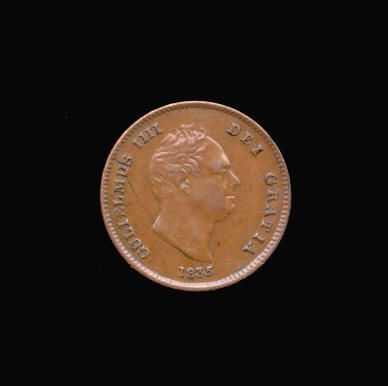
1835 Third-farthing

William's coronation was on the 8th of September in 1831 and a 14-coin coronation proof set was issued in that year.
No five-pound pieces were struck so the set consists of coins from the two-pound piece down, ie, two-pound, sovereign,
half-sovereign, crown, halfcrown, shilling, sixpence, Maundy Set (4 coins), penny, halfpenny, and farthing. A crown was
struck in gold in 1831 as a trial and is often substituted (by those who can afford it!) for the five-pound coin.
The two-pound coin is quite rare, with only 225 pieces having been struck.
During his reign, the groat, or fourpence, was issued again for general circulation and is notable as being the only
silver coin having upon the reverse the seated figure of Britannia, which in all other cases was reserved solely for
the copper coins.
Two different halfcrowns were struck having as a difference the style of the designers initials ("WW" for William Wyon).
On the neck of William IV the more common style is with the letters in script style. In 1831 a proof was struck with
them in block style and a regular issue in 1834 is also of the block style.
Monarchs of England and Great Britain | Coins of England and Great BritainWilliam IV of Great Britain (1831-1837)

1835 Third-farthing